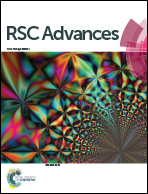Expanding applications of zeolite imidazolate frameworks in catalysis: synthesis of quinazolines using ZIF-67 as an efficient heterogeneous catalyst†
Abstract
A cobalt zeolite imidazolate framework (ZIF-67) was successfully synthesized and characterized by several techniques. The ZIF-67 was used as an efficient heterogeneous catalyst for the cyclization reaction of 2-aminobenzoketones and benzylamine derivatives to form quinazoline products. The optimal conditions involved the use of TBHP oxidant in toluene solvent at 80 °C. Remarkably, the ZIF-67 catalyst exhibited better performance in the cyclization reaction than common cobalt salts such as Co(NO3)2, CoCl2, and Co(OAc)2 and other Co-MOFs such as ZIF-9, Co-MOF-74, and Co2(BDC)2(DABCO). In addition, the cyclization reaction could only proceed in the presence of the solid Co-ZIF catalyst and there was no contribution from leached active sites present in the solution. The catalyst could be recovered and reused several times without a significant degradation in catalytic activity.


 Please wait while we load your content...
Please wait while we load your content...